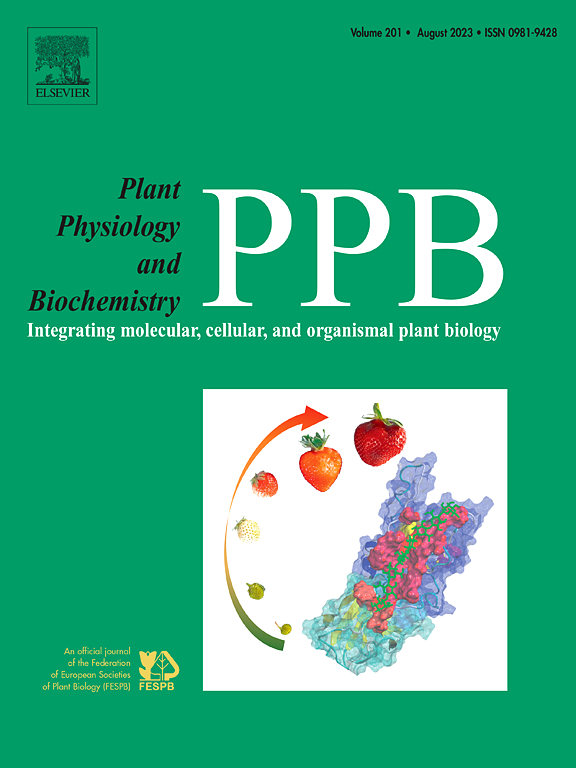Hydrogen sulfide promotes stomatal development through persulfidation of EPF peptides in Arabidopsis
IF 6.1
2区 生物学
Q1 PLANT SCIENCES
引用次数: 0
Abstract
Hydrogen sulfide (H2S) plays a significant role in various processes related to plant growth, development, and responses to environmental stress, particularly affecting stomatal behavior. While numerous studies have documented the impact of H2S on stomatal movement, the effects of H2S on stomatal development remain relatively unexplored, and the underlying mechanisms are not fully understood. Epidermal pattern factors (EPFs) are crucial initiators of the genetic regulatory network governing stomatal development. This study aims to elucidate the regulatory mechanisms of H2S in leaf stomatal development, thereby enhancing our understanding of the role of H2S as a gasotransmitter in plant responses to stress. Observations utilizing light microscopy and cryo-double beam scanning electron microscope revealed that both exogenous and endogenous deficiencies of H2S led to a significant reduction in stomatal density in the newborn leaves of Arabidopsis thaliana. Additionally, the stomatal density of 35S::EPFL9 was also diminished following the exogenous removal of H2S, indicating that H2S may play a role in EPFs-mediated stomatal development. More precisely, EPFL9, EPF2, and EPF1 respond sequentially to H2S signaling at the transcriptional level. Furthermore, label-switching assays indicate that EPF2 and EPFL9 can be persulfidated by H2S at the post-translational level, suggesting that EPF2 and EPFL9 may be the primary responders in this process.
硫化氢通过过硫化EPF肽促进拟南芥气孔发育
硫化氢(H2S)在植物生长发育和对环境胁迫的响应过程中起着重要作用,特别是影响气孔行为。虽然许多研究已经记录了H2S对气孔运动的影响,但H2S对气孔发育的影响仍然相对未被探索,其潜在机制尚未完全了解。表皮模式因子(EPFs)是气孔发育遗传调控网络的重要启动因子。本研究旨在阐明H2S在叶片气孔发育中的调控机制,从而加深我们对H2S作为一种气体传递素在植物逆境响应中的作用的认识。利用光镜和低温双束扫描电镜观察发现,外源和内源H2S缺乏均导致拟南芥新生叶气孔密度显著降低。此外,外源去除H2S后,35S::EPFL9的气孔密度也降低,表明H2S可能在epfs介导的气孔发育中起作用。更准确地说,EPFL9、EPF2和EPF1在转录水平上依次响应H2S信号。此外,标记转换实验表明,EPF2和EPFL9可以在翻译后水平被H2S过硫化,这表明EPF2和EPFL9可能是这一过程的主要应答者。
本文章由计算机程序翻译,如有差异,请以英文原文为准。
求助全文
约1分钟内获得全文
求助全文
来源期刊
CiteScore
11.10
自引率
3.10%
发文量
410
审稿时长
33 days
期刊介绍:
Plant Physiology and Biochemistry publishes original theoretical, experimental and technical contributions in the various fields of plant physiology (biochemistry, physiology, structure, genetics, plant-microbe interactions, etc.) at diverse levels of integration (molecular, subcellular, cellular, organ, whole plant, environmental). Opinions expressed in the journal are the sole responsibility of the authors and publication does not imply the editors'' agreement.
Manuscripts describing molecular-genetic and/or gene expression data that are not integrated with biochemical analysis and/or actual measurements of plant physiological processes are not suitable for PPB. Also "Omics" studies (transcriptomics, proteomics, metabolomics, etc.) reporting descriptive analysis without an element of functional validation assays, will not be considered. Similarly, applied agronomic or phytochemical studies that generate no new, fundamental insights in plant physiological and/or biochemical processes are not suitable for publication in PPB.
Plant Physiology and Biochemistry publishes several types of articles: Reviews, Papers and Short Papers. Articles for Reviews are either invited by the editor or proposed by the authors for the editor''s prior agreement. Reviews should not exceed 40 typewritten pages and Short Papers no more than approximately 8 typewritten pages. The fundamental character of Plant Physiology and Biochemistry remains that of a journal for original results.

 求助内容:
求助内容: 应助结果提醒方式:
应助结果提醒方式:


